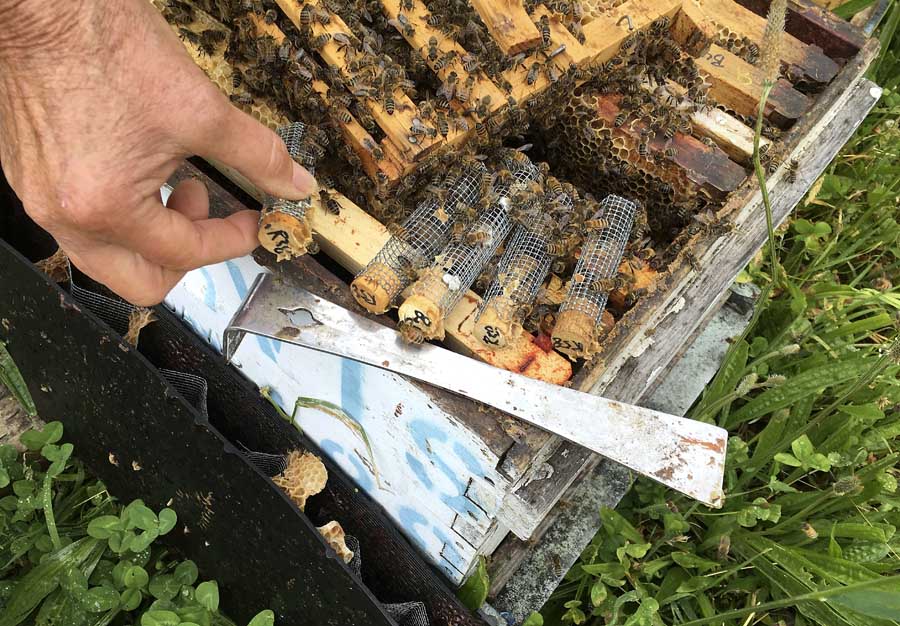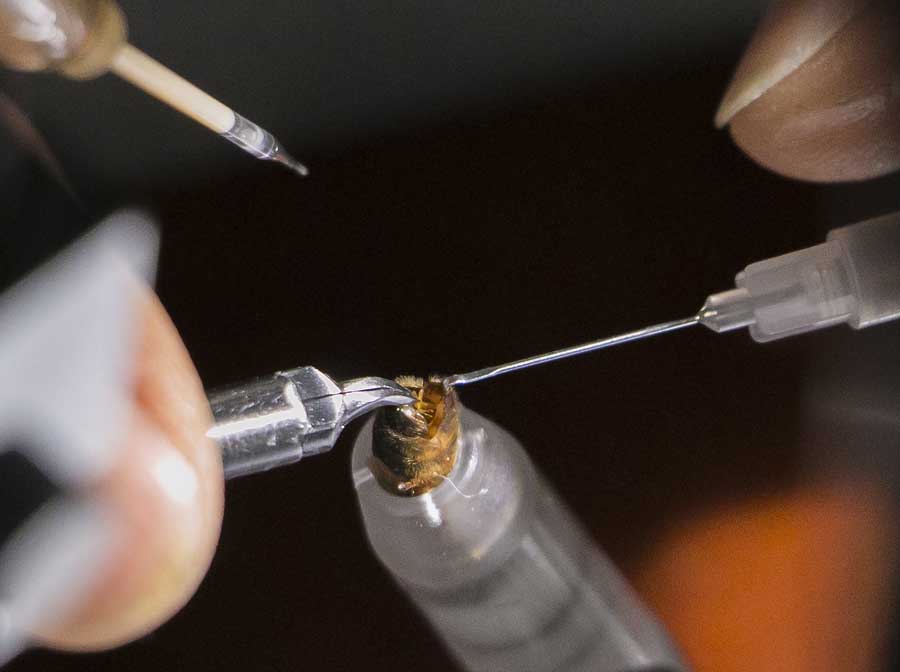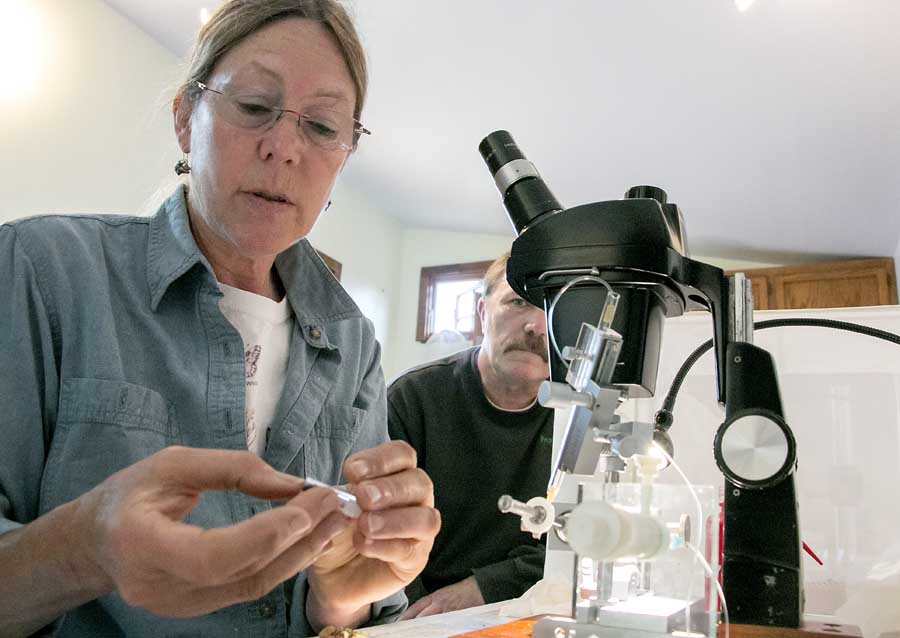Inside her laboratory in Western Washington, Susan Cobey inserts a queen honeybee face down into a plastic tube, opens her abdomen with hooks and gives her a dose of drone semen from a capillary tube. If all goes as planned, the now inseminated queen will lay thousands of eggs and reign over a healthy colony.
This is how Cobey, a bee insemination expert who does breeding work for Washington State University, and her husband, Tim Lawrence, a WSU assistant professor and regional extension honeybee specialist, are doing their part to save our nation’s honeybees.
Normally, queens mate in flight with multiple drones.

Susan Cobey, a honeybee insemination expert, and her husband, Tim Lawrence, breed honeybees in Coupeville, Washington, as part of Washington State University’s efforts to improve the genetic health of the fruit industry’s most important pollinator. Cobey affixes colored tags to the inseminated queens. She also slightly clips one of the queen’s wings, just enough to notice upon close inspection but enough not to stop the queen from flying. (Ross Courtney/Good Fruit Grower)
“What we’re trying to do here is to increase the genetic diversity so we can find solutions to some of the pests and disease problems that bees have,” Lawrence said.
Bees have had it rough the past decade, for a number of reasons. The decline in honeybee numbers has been blamed on several factors, including a surge in parasitic varroa mites, loss of foraging habitat and overuse of certain pesticides, but the high colony die-off rates prompted no less than former President Barack Obama to issue a honeybee sustainability strategy.
Lawrence and his WSU colleagues believe better breeding is part of the long-term solution. The idea is to breed bees that resist the varroa mite, gather more pollen or tolerate cold winters the same way ranchers breed cows to grow meatier flesh or produce more milk.
To do that, however, the bee industry needs a deeper genetic pool, something the university says is already happening and benefiting beekeepers and growers nationally.
History of inbreeding

Cobey checks on recently inseminated queens, kept inside cylindrical cages for one to three days as they are introduced to the hive. Without the cage, the workers could reject the queen and try to replace her but will accept her once she starts laying eggs. (Ross Courtney/Good Fruit Grower)
Left to their own devices, honeybees naturally seek genetic diversity. A queen will mate with an average of 15 — up to a maximum of 40 — different worker bees on a single flight. They frequent a wide variety of flowers. And they compete with other species, such as bumblebees, for pollen.
However, honeybees are not native to North America and were imported with the arrival of European settlers.
That stopped in 1922 when the U.S. government began prohibiting importing bees or any related genetic material to prevent the spread of diseases or pests, and in the decades since, queens have become somewhat inbred. Currently, only 300 too 500 breeder queens produce 1 million to 1.5 million queens each year.
That’s not much diversity. “They’re very sensitive to inbreeding,” said Steve Sheppard, a WSU entomologist and head of the breeding program.
Kick-started by a $1.7 million grant from the U.S. Department of Agriculture in 2000, the university expanded its breeding program, purchasing queens from 200 beekeepers throughout the nation and pairing them with drones of their choosing, Sheppard said. The four-year grant also paid for vehicles, a honey extraction plant and numerous education outreach efforts.
In 2008, the Animal and Plant Health Inspection Service, or APHIS, granted the university a special three-year renewable permit to import semen to boost their breeding efforts. The program got another shot in the arm in 2012, when one of Sheppard’s graduate students developed a cryopreservation technique that enabled semen to be frozen until needed.
About the same time, Lawrence, then one of Sheppard’s postdoctoral researchers, accepted WSU’s Island County extension director position in Coupeville, Washington, and continued the breeding and colony maintenance, while the university hired Cobey for part-time insemination work.

Tim Lawrence, Cobey’s husband and university assistant professor and regional honeybee specialist, uses smoke to make his bees more docile as he checks on the hives in a pasture adjacent to the couple’s cabin-like laboratory in the background. (Ross Courtney/Good Fruit Grower)
Coupeville sits on Whidbey Island, about 30 miles north of Seattle, and its cool, damp climate makes it easier to select sturdy honeybees, Lawrence said. “For honey production, it’s not such a good place, but for doing selection it’s very good. I mean, if the bees can make it here, they can make it just about anywhere.”
A variety of grants from various organizations have sustained the university’s breeding program since the big grant from the U.S. Department of Agriculture. Recently, California almond growers have funded the breeding work.
Instrumental insemination
In addition to breeding bees for the university, Cobey also owns Honeybee Insemination Service, traveling the world and bringing clients to her pastoral Whidbey Island home for training.
When Good Fruit Grower visited on a drizzly day last June, Cobey taught three students — all beekeepers — how to squeeze the endophallus out of a drone, harvest the semen and inject it into the oviducts of the anesthetized queen. “It’s a very specialized technique because we’re dealing with something very small … It’s very tiny, precise, detailed work,” Cobey said.

Cobey prepares to open up the abdomen of a Carniolan queen with a sting hook, left, and a ventral hook to deposit drone semen with the capillary tube into the oviduct. “It’s very tiny, precise, detailed work,” she said. The process takes her about 30 seconds. (Ross Courtney/Good Fruit Grower)
In a week or so, the queen will begin laying eggs and Cobey will begin monitoring the hive for certain characteristics, such as gentleness around human handlers and foraging ability. The hope is to precision breed for those traits at will. “That’s our goal,” she said. “It’s a big one.”
She uses the same technique for the university.
The university quarantines the semen at the university’s main campus in Pullman, Washington, where Cobey does her university inseminations. She and her university colleagues send a sample of the imported semen and a collection of the first progeny to the APHIS laboratory in Beltsville, Maryland, to screen for diseases or pests that would be new to the United States.
Once the agency gives the genetically foreign bees a thumbs up, some of the bees are transported to Whidbey Island or elsewhere for trials and further breeding.
Also, the university receives queens from California bee producers and sends semen and queens back after evaluating them with a number system to help them index traits in the future, moving closer to target breeding with each step.
The university keeps four subspecies of honeybees in the program, with primarily Carniolans on Whidbey Island. Italian honeybees, the most commonly used in the United States, are maintained in California. They perform well in warmer climates and build up a large brood for winter.

Cobey coaxes a honeybee queen into a tube used for insemination. She anesthetizes the queen with carbon-dioxide to put her to sleep and stimulate oviposition. (Ross Courtney/Good Fruit Grower)
The Carniolan bees function well in cooler climates, forage at lower temperatures and build up their colonies quickly in the spring.
Likewise, Caucasian honeybees, maintained primarily at the university’s main campus in Pullman, Washington, forage at relatively low temperatures and tolerate cool climates, but they also have a high collection of propolis, a resin from tree bud they use to seal honeycombs.
The fourth subspecies is Apis mellifera pomonella, also maintained in Pullman. This subspecies has not yet been released for commercial use; in 2015, the Washington Tree Fruit Research Commission provided $10,000 for Sheppard and a colleague to travel to Kazakhstan to procure bee semen native to the same region the apple originated.
The researchers have since been breeding backward to recreate the line — importing the bees themselves is illegal — in hopes of further expanding the genetic diversity. (Read “A new, old bee”)
They believe their efforts are bearing fruit. Every 10 years, university researchers have evaluated genetic diversity of the bee industry’s queens. The genetic pool of queens from Cobey’s collaborators has deepened but has grown shallower in the others.
Meanwhile, a recent batch of honeybees imported under a special permit from mite-free Australia showed much less resistance to varroa mites when they reached the United States than the colonies from the university’s lines.
Queen producers appreciate their research and believe it’s helping the bee industry.
“Clearly they are making genetic advances, and I think it’s definitely a positive,” said Pat Heitkam of Heitkam’s Honey Bees in Orland, California, who raises 35,000 queens per year.
But prevention, by definition, is hard to measure. They don’t know how many varroa mites or some other form of bee decline have not affected their hives.
“It’s kind of that big umbrella of the unknown,” said Buzz Landon, owner of Buzz’s Bees in Richvale, California.
Jackie Park-Burris, a third-generation queen producer in Palo Cedro, California, said Cobey and Lawrence have contributed to the knowledge base of beekeepers, queen producers and fruit producers, but she already knows what kind of bees she’s after.
In fact, she said, the industry has selected for certain traits for decades, and maybe it’s good that the bees lacking those traits are on the wane.
“We want genetic diversity but we want positive genetic diversity,” she said. •
Be good to your bees
Growers might not instrumentally inseminate bees, but Tim Lawrence, Washington State University assistant professor and honeybee specialist, says they can do things in their orchards to boost the genetic diversity and overall health of the hives they place.
—Turn bees on. Keep a wide variety of flowers in the orchard. Let dandelion and clover bloom at the same time as fruit trees. Those flowers will stimulate honeybees to stay active, prompting the queen to lay more eggs, which will in turn encourage the hive to forage even more to feed the larvae.
Lawrence stores his colonies in a pasture of hairy vetch, robinia, psyllia and saffron. He knows of other researchers and farmers who have had positive results with early flowering plants around the perimeter of their orchards.
—Lure the natives. Dandelion, clover and other flowers also will attract native bees, such as bumblebees, which in turn will encourage the honeybees to forage even more aggressively to compete.
—Spray cautiously, mowing cover crops before spraying. Spray at night or early in the morning when bees are less active. Avoid letting sprays reach standing water.
—Provide a source of uncontaminated water, which bees need for thermoregulation in their hives. In drought-stricken California, some 85,000 colonies allegedly died from visiting the only water source they could find, a chemigation valve, Lawrence said.
—Talk to your bee supplier about alternatives. For cooler climates, Caucasian or Carniolan honeybees may perform better than the most common subspecies, Italian honeybees.
— By Ross Courtney






Leave A Comment